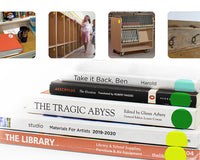
One of the biggest challenges any municipal or school library faces is keeping its books in good condition while they’re in circulation. Printers bind books in a variety of ways, each of which calls for a different approach to repair. In this guide to book binding types and how to repair them, we’ll give you some ideas for how to handle your well-worn books.
Case Binding
The gold standard—or at least the paper standard—for binding, this is the approach of choice for hardcover books. Printers bind the book block one section at a time with durable threads sewing together groups of pages, or signatures. These signatures are glued together and attached to the spine, yielding the most durable book, albeit the most expensive. It can take years for case-bound works to require book binding repair. When it does, librarians recommend a special archival book glue.
Perfect Binding
Don’t let the name throw you—there’s nothing infallible about this approach to binding books. Trade paperbacks use perfect binding, in which the pages that make up the book block get glued into place with a durable adhesive along the spine. The style gets its name from the perfect alignment between the edges of the book block and the cover—unlike hardcovers, there’s no lip. However, even that glue can fail, causing a book to shed pages. If a perfectly bound book encounters some imperfections, Chromalabel can restore it with our lines of book repair tape, which can reinforce spines that need a little extra strength.
Spiral Binding
Associated with business reports and self-published books, a spiral-bound book runs a coil through a stack of well-punched pages, allowing for 360 degrees of page-turning—no permanently cracked spines here. However, it’s among the more uncommon book binding types. Repairing them requires a little work. Pages that get torn out of spiral binding are hard to put back. Chromalabel offers an ideal solution—transform it into a perfectly bound book with book binding tape by unspooling the spiral binding and using this tough tape to hold the book block together.
Saddle Stitch Binding
We’re putting this fourth on the list because saddle stitch binding is all about multiples of four. For this book binding type, each sheet of paper represents four panels, or pages, which printers fold in half and staple together. The style gets its name from how the pages appear when you hold one upside-down: dangling in either direction from the spine, it looks like a person’s legs straddling a horse. You see this binding with booklets, children’s books, and magazines far more often than with full-length books, which are too dense for this to be an effective binding approach. You can repair a saddle stitch book with a little effort. If an entire sheet becomes unbound, use needle-nose pliers to pull the heavy-duty staples back up. Punch new holes in the sheet or align it with existing ones and bend the staples back into place.






